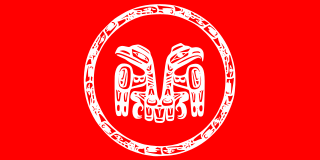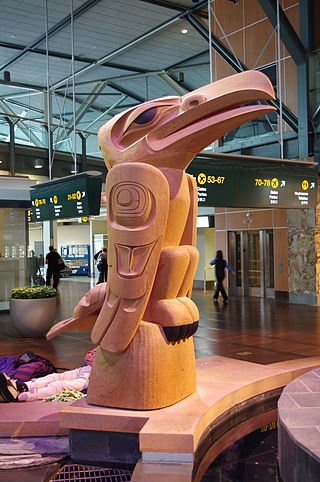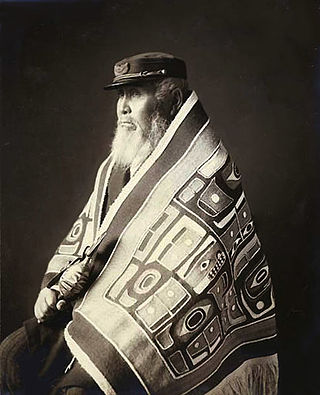Related Research Articles

The Tlingit or Lingít are Alaska Native Indigenous Peoples of the Pacific Northwest Coast of North America and are one of two-hundred twenty-nine (229) federally recognized Tribes of Alaska. Their language is the Tlingit language, in which the name means 'People of the Tides'. The Russian name Koloshi or the related German name Koulischen may be encountered referring to the people in older historical literature, such as Grigory Shelikhov's 1796 map of Russian America. Tlingit people today belong to two federally recognized Alaska Native tribes: the Central Council of the Tlingit & Haida Indian Tribes of Alaska and the Yakutat Tlingit Tribe.

William Ronald Reid Jr. was a Haida artist whose works include jewelry, sculpture, screen-printing, and paintings. Producing over one thousand original works during his fifty-year career, Reid is regarded as one of the most significant Northwest Coast artists of the late twentieth century.

Haida are an Indigenous group who have traditionally occupied Haida Gwaii, an archipelago just off the coast of British Columbia, Canada, for at least 12,500 years.

Totem poles are monumental carvings found in western Canada and the northwestern United States. They are a type of Northwest Coast art, consisting of poles, posts or pillars, carved with symbols or figures. They are usually made from large trees, mostly western red cedar, by First Nations and Indigenous peoples of the Pacific Northwest Coast including northern Northwest Coast Haida, Tlingit, and Tsimshian communities in Southeast Alaska and British Columbia, Kwakwaka'wakw and Nuu-chah-nulth communities in southern British Columbia, and the Coast Salish communities in Washington and British Columbia.

A potlatch is a gift-giving feast practiced by Indigenous peoples of the Pacific Northwest Coast of Canada and the United States, among whom it is traditionally the primary governmental institution, legislative body, and economic system. This includes the Heiltsuk, Haida, Nuxalk, Tlingit, Makah, Tsimshian, Nuu-chah-nulth, Kwakwaka'wakw, and Coast Salish cultures. Potlatches are also a common feature of the peoples of the Interior and of the Subarctic adjoining the Northwest Coast, although mostly without the elaborate ritual and gift-giving economy of the coastal peoples.
The Tlingit clans of Southeast Alaska, in the United States, are one of the Indigenous cultures within Alaska. The Tlingit people also live in the Northwest Interior of British Columbia, Canada, and in the southern Yukon Territory. There are two main Tlingit lineages or moieties within Alaska, which are subdivided into a number of clans and houses.
Seawolf, Sea wolf or Sea Wolves may refer to:

Prehistoric Alaska begins with Paleolithic people moving into northwestern North America sometime between 40,000 and 15,000 years ago across the Bering Land Bridge in western Alaska; a date less than 20,000 years ago is most likely. They found their passage blocked by a huge sheet of ice until a temporary recession in the Wisconsin glaciation opened up an ice-free corridor through northwestern Canada, possibly allowing bands to fan out throughout the rest of the continent. Eventually, Alaska became populated by the Inuit and a variety of Native American groups. Trade with both Asia and southern tribes was active even before the advent of Europeans.

Dempsey Bob, is a Northwest Coast woodcarver and sculptor from British Columbia, Canada, who is of Tahltan and Tlingit First Nations descent. He was born in the Tahltan village of Telegraph Creek on the Stikine River in northwestern B.C., and is of the Wolf clan.

Charles Edenshaw was a Haida artist from Haida Gwaii, British Columbia. He is known for his woodcarving, argillite carving, jewellery, and painting. His style was known for its originality and innovative narrative forms, created while adhering to the principles of formline art characteristic of Haida art. In 1902, the ethnographer and collector Charles F. Newcombe called Edenshaw “the best carver in wood and stone now living.”

Northwest Coast art is the term commonly applied to a style of art created primarily by artists from Tlingit, Haida, Heiltsuk, Nuxalk, Tsimshian, Kwakwaka'wakw, Nuu-chah-nulth and other First Nations and Native American tribes of the Northwest Coast of North America, from pre-European-contact times up to the present.

The Indigenous peoples of the Pacific Northwest Coast are composed of many nations and tribal affiliations, each with distinctive cultural and political identities. They share certain beliefs, traditions and practices, such as the centrality of salmon as a resource and spiritual symbol, and many cultivation and subsistence practices. The term Northwest Coast or North West Coast is used in anthropology to refer to the groups of Indigenous people residing along the coast of what is now called British Columbia, Washington State, parts of Alaska, Oregon, and Northern California. The term Pacific Northwest is largely used in the American context.

The culture of the Tlingit, an Indigenous people from Alaska, British Columbia, and the Yukon, is multifaceted, a characteristic of Northwest Coast peoples with access to easily exploited rich resources. In Tlingit culture a heavy emphasis is placed upon family and kinship, and on a rich tradition of oratory. Wealth and economic power are important indicators of status, but so is generosity and proper behavior, all signs of "good breeding" and ties to aristocracy. Art and spirituality are incorporated in nearly all areas of Tlingit culture, with even everyday objects such as spoons and storage boxes decorated and imbued with spiritual power and historical associations.

The Vancouver Island wolf, also known as the coastal wolf or sea wolf is a subspecies of grey wolf, endemic to the coast of the Pacific Northwest. They are a unique species of wolf due to their semi-aquatic lifestyle, which includes a diet that is almost entirely marine-based.

Chilkat weaving is a traditional form of weaving practiced by Tlingit, Haida, Tsimshian, and other Northwest Coast peoples of Alaska and British Columbia. Chilkat robes are worn by high-ranking tribal members on civic or ceremonial occasions, including dances. The blankets are almost always black, white, yellow and blue.
Primrose Adams was a Canadian First Nations artist and member of the Raven Clan from the Haida nation. She wove hats and baskets in the Haida method and is most notable for her spruce root basketry, which involves working in the traditional manner of collecting and dyeing her own spruce root. Adams died in January 2020.
Doug Cranmer (1927–2006), also known as Pal'nakwala Wakas and Kesu', was a Kwakwaka'wakw carver and artist as well as a 'Namgis chief. Cranmer was a significant figure in the Northwest Coast art movement, both in its traditional form and in a modern contemporary form that he created and developed.

The Alaska Anchorage Seawolves are the 13 varsity athletic teams that represent the University of Alaska Anchorage (UAA), in Anchorage, Alaska, United States, in NCAA intercollegiate sports. The vast majority of UAA's athletic teams are in NCAA Division II, with the exception of the women's gymnastics and men's ice hockey teams, which are members of Division I.
The 1862 Pacific Northwest smallpox epidemic was a smallpox outbreak that started in Victoria on Vancouver Island and spread among the indigenous peoples of the Pacific Northwest Coast and into the indigenous peoples of the Northwest Plateau, killing a large portion of natives from the Puget Sound region to Southeast Alaska. Two-thirds of British Columbia natives died—around 20,000 people. The death rate was highest in southeast Alaska and Haida Gwaii—over 70% among the Haida and 60% among the Tlingit. Almost all native nations along the coast, and many in the interior, were devastated, with a death rate of over 50% for the entire coast from Puget Sound to Sitka, Alaska, part of Russian America at the time. In some areas the native population fell by as much as 90%. The disease was controlled among colonists in 1862 but it continued to spread among natives through 1863.

Ravenstail weaving, also known as Raven's Tail weaving, is a traditional form of geometric weaving-style practiced by Northwest Coast peoples.
References
- 1 2 "What is a Seawolf?". www.uaa.alaska.edu. August 23, 2013. Retrieved January 23, 2022.
- ↑ "UAA Traditions: What's a Seawolf?". University of Alaska Anchorage. Retrieved January 23, 2022.
- ↑ "The Gonakadet, or Wasgo". www.jludwick.com. Retrieved January 23, 2022.
- ↑ "Artwork". ArtsWA. Retrieved January 23, 2022.
- ↑ Faris, Peter (September 25, 2018). "Rock Art Blog: WASGO/GONAKADET - SEA WOLVES OF THE PACIFIC NORTHWEST COAST". Rock Art Blog. Archived from the original on January 24, 2022. Retrieved January 24, 2022.